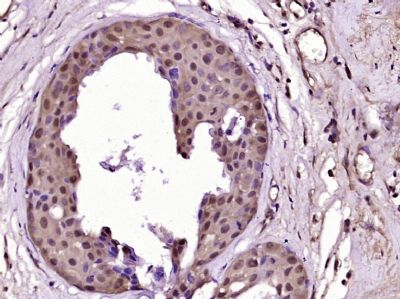This gene encodes a protein that may function in tumor suppression. This protein binds to and colocalizes with the breast cancer 2 early onset protein (BRCA2) in nuclear foci and likely permits the stable intranuclear localization and accumulation of BRCA2. Essential partner of BRCA2 that promotes the localization and stability of BRCA2. Also enables its recombinational repair and checkpoint functions of BRCA2. May act by promoting stable association of BRCA2 with nuclear structures, allowing BRCA2 to escape the effects of proteosome-mediated degradation.
Function:
Plays a critical role in homologous recombination repair (HRR) through its ability to recruit BRCA2 and RAD51 to DNA breaks. Serves as the molecular scaffold in the formation of the BRCA1-PALB2-BRCA2 complex which is essential for homologous recombination. Strongly stimulates the DNA strand-invasion activity of RAD51, stabilizes the nucleoprotein filament against a disruptive BRC3-BRC4 polypeptide and helps RAD51 to overcome the suppressive effect of replication protein A (RPA). Functionally cooperates with RAD51AP1 in promoting of D-loop formation by RAD51. Essential partner of BRCA2 that promotes the localization and stability of BRCA2. Also enables its recombinational repair and checkpoint functions of BRCA2. May act by promoting stable association of BRCA2 with nuclear structures, allowing BRCA2 to escape the effects of proteasome-mediated degradation. Binds DNA with high affinity for D loop, which comprises single-stranded, double-stranded and branched DNA structures.
Subunit:
Homooligomer. Oligomerization is essential for its focal accumulation at DNA breaks. Part of a trimeric complex containing BRCA1, BRCA2 and PALB2. Interacts with BRCA1 and this interaction is essential for its function in HRR. Interacts with RAD51, BRCA2, RAD51AP1 and MORF4L1/MRG15.
Subcellular Location:
Nucleus. Note=Colocalizes with BRCA2 in nuclear foci.
DISEASE:
Breast cancer (BC) [MIM:11496]: A common malignancy originating from breast epithelial tissue. Breast neoplasms can be distinguished by their histologic pattern. Invasive ductal carcinoma is by far the most common type. Breast cancer is etiologically and genetically heterogeneous. Important genetic factors have been indicated by familial occurrence and bilateral involvement. Mutations at more than one locus can be involved in different families or even in the same case. Note=Disease susceptibility is associated with variations affecting the gene represented in this entry. Breast cancer susceptibility is strongly associated with PALB2 truncating mutations. Conversely, rare missense mutations do not strongly influence breast cancer risk (PubMed:22241545).
Fanconi anemia complementation group N (FANCN) [MIM:610832]: A disorder affecting all bone marrow elements and resulting in anemia, leukopenia and thrombopenia. It is associated with cardiac, renal and limb malformations, dermal pigmentary changes, and a predisposition to the development of malignancies. At the cellular level it is associated with hypersensitivity to DNA-damaging agents, chromosomal instability (increased chromosome breakage) and defective DNA repair. Note=The disease is caused by mutations affecting the gene represented in this entry.
Pancreatic cancer 3 (PNCA3) [MIM:613348]: A malignant neoplasm of the pancreas. Tumors can arise from both the exocrine and endocrine portions of the pancreas, but 95% of them develop from the exocrine portion, including the ductal epithelium, acinar cells, connective tissue, and lymphatic tissue. Note=The disease is caused by mutations affecting the gene represented in this entry.
Similarity:
Contains 7 WD repeats.
SWISS:
Q86YC2
Gene ID:
79728
Database links:
Entrez Gene: 79728 Human
Entrez Gene: 233826 Mouse
Entrez Gene: 293452 Rat
Omim: 610355 Human
SwissProt: Q86YC2 Human
SwissProt: Q3U0P1 Mouse
Unigene: 444664 Human
Unigene: 38348 Mouse
Unigene: 43638 Rat
| Picture |
Paraformaldehyde-fixed, paraffin embedded (Human breast cancer); Antigen retrieval by boiling in sodium citrate buffer (pH6.0) for 15min; Block endogenous peroxidase by 3% hydrogen peroxide for 20 minutes; Blocking buffer (normal goat serum) at 37°C for 30min; Antibody incubation with (PALB2) Polyclonal Antibody, Unconjugated (SL23346R) at 1:400 overnight at 4°C, followed by operating according to SP Kit(Rabbit) (sp-0023) instructions and DAB staining.
|
|
|
